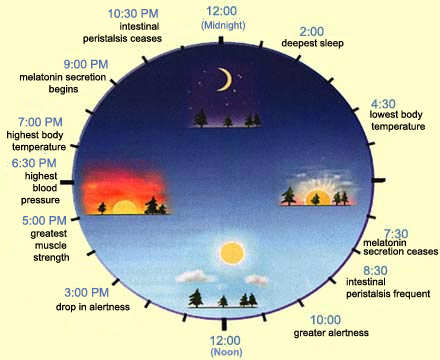Behavioral Neuroscience
Summers
Sensory input for Rhythmicity
Afferent path to the SCN
Figures of Rhythmicity
Retina-RGC-SCN

Efferent SCN output
Integration of Rhythms into Behavior
Molecular SCN
end Acronyms/Abbreviations Syllabus
VIP
AVP
GABA
5-HT
BIOLOGICAL RHYTHMS I. Behavior of Rhythmicity A. Behavioral and Physiological responses exhibit predictable changes over time 1. Rhythmically repeating responses a. oscillations with periods from milliseconds to years b. complement environmentally salient events i. e.g. seasons, daybreak, high tide c. merge physiological functions i. e.g. HPA (stress hormone) acrophase and wakefulness ii. e.g. activity and body temperature 2. Biologically adaptive
B. Increased efficiency - Energy Management 1. most animals and plants follow a pattern of either diurnally or nocturnally increased metabolic activity 2. Advantages: a. decreased i. total energy expenditure, predator presence b. increased i. availability of moisture (dew), photosynthesis metabolic turnover for poikilotherms, prey availability c. hibernation/migration
C. Periodicity 1. Yearly/Seasonally a. even multiple years 2. Monthly/lunar cycle 3. two weeks 4. daily, Diurnal or Nycthemeral 5. shorter than one day a. a variety D. Origin of Rhythmicity 1. exogenous rhythms a. passive reaction to peroidic input from the environment 2. enodogenous rhythms a. internally driven i. oscillator(s) (1) biological clock(s) b. Entrainable i. can be made to match current env. pattern (1) setting or resetting biological clocks ii. zeitgeiber = time giver (1) often light (always in birds)(solar & lunar) (2) also temperature, moisture, water pressure, sound, food availability, greeness, magnatism, gravity, others? iii. window(s) for clock setting sensitivity (1) night sensitivity greatest (a) morning sensitivity also high (2) resetting jet-lag easiest going from east to west c. free running period i. length of cycle without zeitgeibers (1) varies from species to species (2) varies between individuals ii. Circannual Rhythms about a year iii. Circalunar 28 days v. Circatidal (1) Spring/Neap 13-14 days (2) Daily High/Low 12 - 13 h vi. Circadian Rhythms 23 to 28 h vii. Ultradian rhythms shorter than 24 h (1) pulsatile seconds/minutes/ 1 hour E. Oscillators 1. Most cells have a free-running periodicity 2. suprachiasmatic nucleus (SCN) a. primary oscillator i. master clock (1) organizes other oscillators (2) synchronizes other oscillators ii. located just above the optic chiasm in the hypothalamus (1) core and shell regions 3. other oscillators: retina, pineal, habenula, other hypothalamic nuclei 4. Frequency and Phase a. frequency = period = length of one cycle b. phase = instantaneous state of an oscillation i. acrophase = peak in the cycle (1) nadir = low point ii. phase shifting (1) acrophase may change to another time of day iii. altering the frequency automatically shifts the phase iv. phase angle = difference in phase between 2 oscillations 4. Multiple vs Single oscillator systems a. variable rhythm periodicity within an organism i. circa: annual, lunar, tidal, dian b. phase synchronization i. two or more rhythms with the same or complementary frequency and phase ii. desynchronization: rhythms may be phase shifted under strong zeitgeiber influence iii. yearly patterns may be related to circadian patterns with different frequencies or different zeitgeibers that come into phase once a year c. split rhythms i. bimodal patterns F. Examples 1. Circannual: reproduction, migration, hibernation, molting, antler growth, rut, courting, nesting, parental behavior, dispersal 2. Circalunar: gruion feeding, rectal temperatures, menstrual cycles 3. Circatidal: oysters opening shell valves, crab feeding/locomotion 4. Circadian: sleeping/wakefulness, HPA axis, activity, body temperature 5. Ultradian: pulsatile hormone release - GnRH, LH, FSH, CRH, ACTH, B